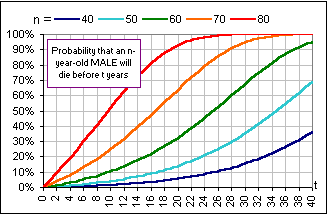| Life Expectancy and Cost of a Life Annuity |
In a neat (and mathematical)
paper,
in PDF format, Milevsky & Robinson discuss Life Annuities in a novel way
... well, it's novel to me. So I thought it'd be fun to (try) to explain the gist of the paper.
>With no math? Good!
Well ... some math, which you can skip over. Now, pay attention.
We start with a review of cumulative probability distributions for, say, life expectancy:
(See this for more on
cumulative distributions.)
We suppose:
|
 Fig. 1 |
 Fig. 2 |
If we call the slope of the cumulative distribution f(x), then we see (from Fig. 1) that (for small Δx)
This guy, f(x), is called the Density Distribution. This is illustrated in Fig. 2.
|
>It's 100% certain you'll die within an infinite number of years, right?
Right, and that means that the total area under the curve y = f(x) must be "1" and that means that
K
 = 1, but since
(surprise!)
= 1, but since
(surprise!) Γ(n+1) =
 is called the Gamma function and has the value Γ(n+1) = n!
is called the Gamma function and has the value Γ(n+1) = n!
(that's n factorial, where for example, 4! = (1)(2)(3)(4) = 24), and we find that K must be 1/n!, so our density distribution is:
>You said no math!
I said some math, now pay attention. Since F(x) is the area under f(x), from "0" to "x", this means that

These formulas describe the so-called Gamma distribution.
>So that's gives the mortality data? But what about ...
Patience. This is just an example to illustrate the notion of finding a distribution which
describes death rates and the probability of living another x years. However, it's neat to do the following:
You're n years old and you want to know how many years you can expect to live:
the average value of x. For a density distribution f, this average
is  which,
when we stick in f = (1/n!) xn e-x, gives
(1/n!)Γ(n+2) =
(1/n!)(n+1)! = n+1
which,
when we stick in f = (1/n!) xn e-x, gives
(1/n!)Γ(n+2) =
(1/n!)(n+1)! = n+1
>So, if I'm 50, so n = 50, I can expect to live another n+1 or 51 years? Are you kidding? I mean ...
I've already told you. This is just an example to illustrate the notion of finding ...
>So, can you do something sensible?
|
What we'll actually use is the following:
We assume that the death rate for t-year-olds increases with age and is given by the Gompertz formula C ekt (where C and k are some as-yet-unknown constants).
In other words, Benjamin Gompertz noted that the death rate (deaths per unit population,
measured, for example, in deaths per year per thousand population)
increased exponentially with age (or, what is the same thing, geometrically with age).
When plotted on a logarithmic scale, the death rate is nearly a straight line.
Yes. Pay attention.
Note that if we put t = n we get the population of n-year-olds,
namely:
|

Fig. 3
|
>Look at Figure 4! Nearly everybuddy is dead by age 60!
The numbers B and k must be picked to mimic actual mortality tables. The values I picked for Fig. 4 are just ... uh, inventions.
Okay. Look at the blue stuff, above.
If it has the value 0.56 it means that, after t years,
there are only 56% of the n-year-old population left ... hence a 56% probability of
surviving for t years. That means that (for this example)
44% will have died before t years have elapsed. Hence, in order to get the
probability of death (rather than the probability of surviving t years),
we consider
1 - blue stuff which we can rearrange to get:
1 - exp{ B ekn(1 - ekt)} where B and k are constants |
F(n,t) = 1 -  where m and c are constants |
- Males: m = 88.18 and c = 10.5
- Females: m = 92.63 and c = 8.78
and, for males, we get:
We use this formula to generate pictures like so:


>Okay, so this is your cumulative distribution, but what about ...?
The density distribution? Here it is (based upon the above estimates):

|
>No! I was going to ask ... what about annuities? Yes, let's consider annuities, but first you can play with the formula ... | 
|

|
>Do Canadians live longer? I'll let you know in a few years ... >Can't you just change those parameters? Pick another m and c?
>But Canadians would die sooner, right?
| 
|
Here's a calculator using the parameters which give a better match to the U.S. data:
|
Another Estimate |
 for PART II on annuities.
for PART II on annuities.


